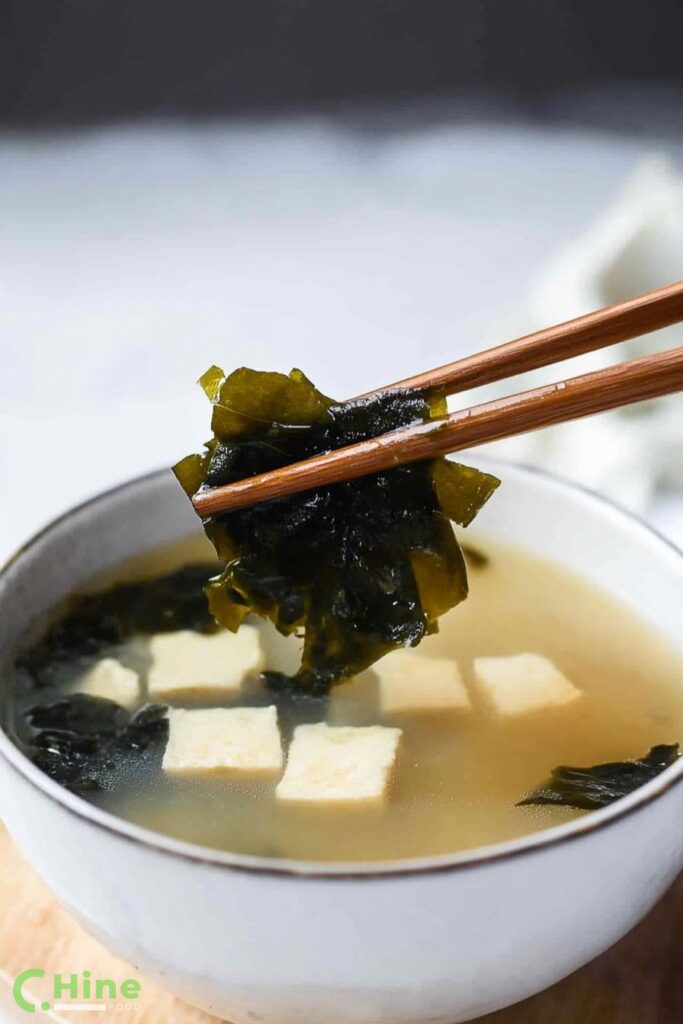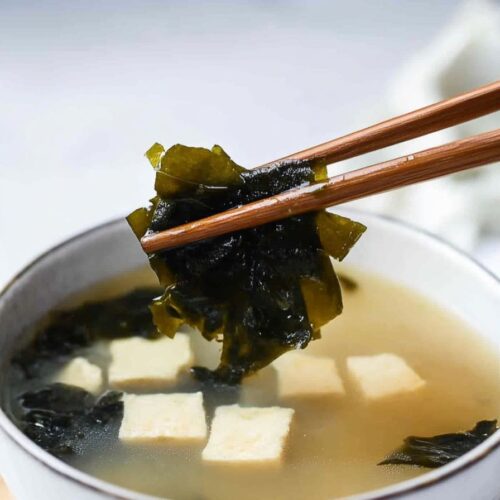
Miso soup is a comforting and beloved staple in Japanese cuisine. At its heart lies dashi, a savory stock made from dried bonito flakes and kombu kelp, which gives the soup its unique umami flavor. This traditional dish has many variations across Japan, often featuring different types of miso paste like red, yellow, or the milder shiro miso that I prefer.
What I love about miso soup is how its simplicity allows for personal touches. You can find versions with ingredients like shiitake mushrooms or daikon radish, each bringing its own twist. In Japan, miso soup is typically enjoyed with rice as part of a main meal, while in the US, it’s often served as an appetizer. Whether you’re a seasoned miso soup enthusiast or trying it for the first time, this recipe brings a taste of Japan right to your kitchen.
Ingredients & Substitutes
Here are the ingredients you will need for traditional Japanese miso soup along with some possible substitutes:
- Dashi Stock
- 4 cups water
- 1 piece kombu kelp (about 4 x 4 inches)
- 1/2 cup bonito flakes
- Substitute: Use vegetable broth for a vegetarian option.
- Miso Paste
- 3 tablespoons white miso paste
- Substitute: Yellow or red miso paste for a stronger flavor.
- Tofu
- 1/2 cup firm tofu, cubed
- Substitute: Silken tofu for a softer texture.
- Wakame Seaweed
- 2 tablespoons dried wakame seaweed
- Substitute: Nori seaweed, but use sparingly due to its strong flavor.
- 2 green onions, thinly sliced
- Substitute: Chives for a milder taste.
These elements bring the authentic taste of Japan right into your kitchen. Adjust the substitutes as per dietary preferences to continue enjoying the rich umami flavors of miso soup.
Instructions
- Prepare the Dashi Stock:
Begin by soaking a 4-inch piece of kombu kelp in 4 cups of water for 30 minutes in a pot. Heat the pot over medium heat and remove the kelp just before the water boils. Then add 1 cup of bonito flakes and let it simmer for 5 minutes. Strain the stock into a bowl and set it aside. - Dice the Tofu:
While the dashi is simmering prepare 7 ounces of soft tofu. Cut the tofu into small 1/2-inch cubes and set these aside. - Rehydrate Wakame Seaweed:
Place 2 tablespoons of dried wakame seaweed in a small bowl. Cover with cold water and soak for about 5 minutes until the seaweed is rehydrated. Drain the excess water. - Mix Miso Paste:
In a small bowl, mix 3 tablespoons of miso paste with a ladleful of the warm dashi stock. Stir until the miso is fully dissolved. This helps avoid clumping when added to the pot. - Combine Ingredients:
Return the strained dashi stock to the pot over low heat. Add the cubed tofu and rehydrated wakame. Slowly introduce the miso mixture, stirring gently to combine. - Heat the Soup:
Warm the soup but make sure it does not boil. Heating miso too much ruins its flavor and health benefits. Keep on low for about 5 minutes, stirring occasionally. - Serve:
Pour the miso soup into bowls and enjoy it warm. This soup pairs beautifully with steamed rice or as a comforting start to a meal.

FAQ
What Is Miso Soup Made Of?
Miso soup is mainly made of dashi stock, miso paste, tofu, and wakame seaweed. Each ingredient brings unique flavor and texture. You can also add vegetables like green onions or mushrooms for more variety.
Can I Use Vegetable Stock Instead Of Dashi?
Yes, you can use vegetable stock if you prefer a vegetarian option. Although the taste may differ slightly from traditional dashi, it still offers a lovely flavor.
Is Miso Soup Gluten-Free?
Regular miso paste is made from soybeans and is typically gluten-free. However, some varieties contain grains like barley. Check the label to ensure it suits your dietary needs.
How Do I Store Leftover Miso Soup?
I recommend storing leftover miso soup in an airtight container in the refrigerator. It should be consumed within two days for optimal freshness. Reheat it gently on the stove without boiling to preserve the flavor.
Can I Freeze Miso Soup?
Freezing miso soup is not advisable as tofu and wakame seaweed may change in texture. It’s best enjoyed fresh or within a couple of days from the fridge.
Why Shouldn’t I Boil Miso Soup?
Boiling miso soup can destroy the beneficial bacteria and dull the flavor. Heating it gently allows you to enjoy both the taste and health benefits fully.

Authentic Japanese Traditional Miso Soup Recipe: Easy and Delicious Steps
Ingredients
- 4 cups of dashi stock
- 1/2 cup of tofu, diced into small cubes
- 2 tablespoons of dried wakame seaweed
- 2 green onions, thinly sliced
Instructions
- Prepare Dashi Stock: Begin by warming 4 cups of dashi stock in a medium-sized pot over medium heat. This forms the base of your miso soup.
- Rehydrate the Wakame: Place 2 tablespoons of dried wakame seaweed in a small bowl with water. Let it soak for about 5 minutes until it expands and softens. Once ready, drain the excess water.
- Dice the Tofu: While the wakame soaks, dice 1/2 cup of tofu into small, bite-sized cubes. This step ensures even distribution throughout the soup.
- Mix Miso Paste: In a separate small bowl, take 3 tablespoons of miso paste. Add a little warm dashi stock from the pot to the miso and mix until smooth. This helps dissolve the paste without forming lumps.
- Combine Ingredients: Lower the heat to prevent boiling. Add the rehydrated wakame and diced tofu to the dashi in the pot. Stir gently to avoid breaking the tofu.
- Add Miso Mixture: Slowly add the miso mixture to the pot. Stir well to blend the flavors while making sure the soup does not boil, preserving the miso's nutrients and flavor.
- Finish with Green Onions: Finally, sprinkle the thinly sliced green onions over the top before serving for a fresh, aromatic touch.
Nutrition
Exploring the world of Japanese traditional miso soup has been a delightful journey for me and I hope it has been for you too. I encourage you to try making this versatile dish at home and experiment with different ingredients to suit your taste. Share your experiences and any unique twists you’ve added in the comments below. I’m eager to hear how you incorporate miso soup into your meals and any tips you might have for fellow readers. Don’t hesitate to ask questions or seek clarification on any part of the recipe. Together we can celebrate the comforting essence of this beloved Japanese staple.



Leave a Reply